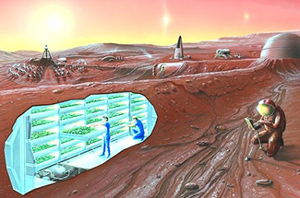Choosing Confinement...
News story originally written on October 15, 1997
Four people have volunteered to live in confined quarters for 90 days as a part of the Lunar-Mars Life Support Test Project. This is the 4th in a series of tests being run at the Johnson Space Center, in Houston, Texas. The crew of four will live in an air-tight chamber environment through late December in order to test life support systems that would be used for future space colonization on the Moon or on Mars.
Within the crew's 20-foot chamber is all that is needed to sustain life for the 90 days. All the water used by the crew will be recycled using a unique biological and chemical water recovery system designed at Johnson. A module that contains wheat crops is linked to the test chamber. This wheat recycles the crew's exhaled carbon dioxide and provides the crew with 25% of the oxygen they need. Solid waste from the crew will be incinerated to produce the remaining carbon dioxide needed to sustain plant growth.
During their confinement, the crew will conduct 14 demonstration projects ranging from physiological medical exams, to psychological investigations, to evaluations of the food systems provided in the chamber.
The test crew members are Crew Commander Dr. Nigel Packham (36, Lockheed-Martin Life Support System Scientist), Vickie Kloeris (41, NASA Shuttle Food System Manager), John Lewis (30, Lockheed-Martin Life Support System Engineer) and Laura Supra (28, Allied Signal Life Support System Engineer).















